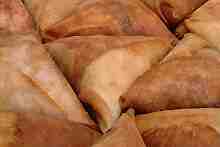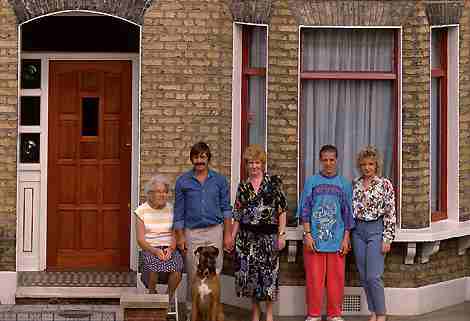"Photograph your home town"
Newham, a borough to the East of London is twinned or has exchanges with
Alingsas, Sweden; Kaiserslautern, Germany; and the Oktyabrsky District in
Moscow, U.S.S.R. I have lived in Nemo for over 15 years and over a period
of time I have built up a collection of photographs taken in the area. I
know that many photographers document their Newham, and familiarality with
a subject should produce really great results. My view is that if one can
not take great pictures within a mile of ones home, one cannot take great
pictures at all. Several years ago my pictures of local tower blocks and
endless traffic had inspired the judges of Europhot organisation to award
me the "Council of Europe" prize for my efforts, I continued taking
pictures close to home but I never the considered the pictures showing my
home town would meet with the same type of appreciation again.
 Samozas sum up Newham's cultural diversity
Samozas sum up Newham's cultural diversity
Recently I was asked to produce a set of prints showing an aspect of the
U.K, for exhibition in the Soviet Union. My collection of photographs taken
locally seemed to fit the brief, and the process of choosing which pictures
to print became a difficult task. It is important to consider that personal
favourites may not be interesting to a wide audience.
Photographs that are for the public at large, and not other photographers
who may be concerned with the appreciation of high quality and perfect technique.
The key issue is a question of communication, so dark and moody photographs
as well as the really obscure subjects are out of the question. I often
visit photography exhibitions, and am I usually impressed by the clearest
of photographs, irrespective of the subject matter. The photographs that
seem to be a few highlights creeping out of the shadows, excite me the least.
There may be some desire to create an "impact" picture using large
amounts of shadow area but there is little information offered by this effect.
In many exhibitions of black/white photographs there are sometimes a large
number of prints with a very limited range of tones, rather than photographs
that display a full range of greys. Photographs taken on fine grain film
on medium or large format cameras, showing the full range of of tones available
seem to have become the exception today. I reflect to consider if pictures
of my home town reduced to a few tones and large grey areas of black shadow
would be of general interest. Imagine going to see an exhibition of photographs
taken in the U.S.A and visiting a collection of dark prints that are difficult
to interpret?
Being concerned about high standards, and producing a set of pictures for
exhibition, is a matter that is easy to talk about, but much harder to achieve.
Taking pictures in a short space of time is the hardest task of all. The
weather is often unsuitable for location photography at the time when it
may be important to produce a set of prints for exhibition at short notice.
The alternative approach is to have a body of work ready for printing. The
example of documenting ones home town could be a project that could span
several years, with locations photographed in ideal conditions. Eventually
a unique collection of photographs would be available for exhibition or
publication. I know that one may easily suggest that if everybody did it
it would not be unique or worthwhile. The point that I wish to make is that
the individual photographs will be similar to other photographs that may
have been taken by many amateur or professional photographers, but very
few photographers will have the "full hand". It is holding the
"full hand" that is the most significant aspect of providing pictures
of a specific subject or area.

A family on Parade
My own pictures are taken on various types of equipment. The pictures I
the square format are taken on a modern reflex system camera, and the pictures
in the 6x12 and 6x9 formats are roll film backs in various 5x4 cameras,
using lenses from 65mm to 720mm. The 5x4 monorail is the camera that I prefer
to use with a roll film back. I think it is worth the effort to use the
most suitable camera available, so the monorail for architecture and city
scenes is the best camera for the job. I shoot on transparency film, but
there is no reason why similar high quality results could not be achieved
on medium or large format print film. Unfortunately most users of photography
are used to seeing transparencies so photographers shooting negatives would
need to provide the transparencies or prints to be viewed. Transparencies
from negatives are still an expensive option, and the more reasonable cost
involved in producing a set of prints from negatives does not compare to
the cost of producing original transparencies. There are moves to use more
colour negative materials in areas of publishing that have traditionally
used transparencies. Whilst it is possible to achieve the same results technically
from negatives and transparencies, storing negatives requires requires a
positive print or transparency as a guide. Until economical ways or storing
a large volume scanned negatives is available, transparency films will remain
as the standard material for photographs used for publication. It is not
my intention to suggest that transparency film use is old fashioned, but
to point out that photographers using negative film will in the future be
able to store and catalogue their picture collections as efficiently as
those photographers using transparencies. For any photographer embarking
on a long term project, examining future trends is a valid exercise. I selected
pictures showing different aspects of life in Newham, a family outside their
house, a pattern of old street cobbles, distinctive architecture, and the
boundary with the river Thames including the Thames barrier.

Familar Barrier
The Thames barrier is probably the most famous landmark in Newham and any
photographer taking pictures in their own area should consider that there
may be one landmark that should be well documented. Once a set of picture
suitable for exhibition are available, there may be many organisations willing
to consider offering a space for the display. The only matter that the photographer
has to decide is who is going to be pay for the prints. Prints that are
10x8 or smaller are not too expensive, but 12x15 and larger sizes could
be outside the scope of any budget where there are no fees payable. In some
cases, a laboratory may be willing to produce a set of prints as a promotional
effort. The laboratory would be in a position to sell reprints and would
not have to pay for the exhibition area. The local authority may be interested
and there may be a need for pictures to satisfy the demands the local history
department of the library service.
The local newspaper may be the first avenue to explore in promoting a collection
of photographs of the area. Do not assume that just because the local paper
is producing pictures constantly, that they would be the best source of
local photographs for exhibitions. Most of the material may be in black/white
and there may not be a comprehensive catalogue of pictures taken. The subjects
taken for a weekly newspaper, would be quite different to a long term photographic
study of an area, so there would be not be any conflict of interest. The
newspaper would be pleased to have some extra pictures to accompany a news
item, and would probably print one or two pictures. In my own experience,
the local newspaper was more interested in a photograph of me holding a
camera, when I offered them prizewinning pictures of the local area in the
for of 35mm slides. A few 10x8 black/white prints with a suitable note may
have been used more readily. If the newspaper is published in colour, as
a few local papers are today, telephone them to ask them what they prefer,
colour prints, or slides, and the format of print or slide could be useful.
The golden rule is to make the use of your pictures as easy as possible.
There is no urgency for this type of feature so they may wish to hold it
for a few months. Armed with a few press cuttings about the exhibition pictures,
and a few sample prints, a letter to the office of the twin town, may draw
a favourable response.
Local picture framers who often sell art prints could be approached to display
one framed print with a set of small prints to show the range of prints
that could be ordered. For pictures to be displayed for a considerable length
of time, the Cibachrome print is the least likely to fade, but they are
more expensive than normal prints produced from negatives or transparencies.
The options for promoting an exhibition are endless, but do not loose sight
of the primary objective, that is to communicate. To frustrate the viewer
with obscure images, plucked from impossible negatives, may be suitable
for the very specialist photography gallery. However, the average visitor
to an exhibition will be impressed with the clarity of first class technique,
illuminating the area for the viewer who is familiar with the subject, and
interesting for any visitor whose first impressions will be made by a display
of your work.
Return to Photon June 96 Content
 Samozas sum up Newham's cultural diversity
Samozas sum up Newham's cultural diversity
